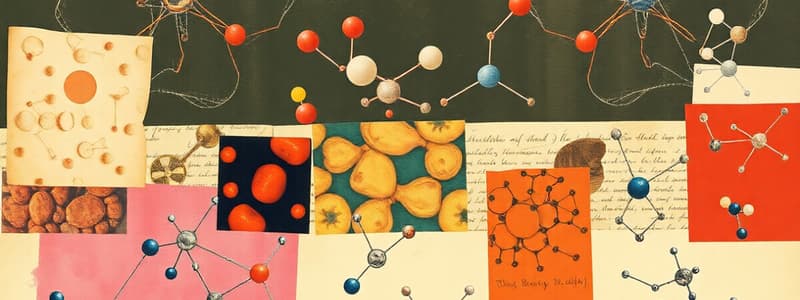Podcast
Questions and Answers
Which of the following functional groups is NOT commonly found in biomolecules?
Which of the following functional groups is NOT commonly found in biomolecules?
- Ketone (correct)
- Sulfhydryl
- Phosphate
- Methyl
What is the primary process by which biomolecules are broken down?
What is the primary process by which biomolecules are broken down?
- Condensation
- Oxidation
- Dehydration
- Hydrolysis (correct)
Which of these molecules is NOT considered a biomolecule based on the provided information?
Which of these molecules is NOT considered a biomolecule based on the provided information?
- Water (correct)
- ATP
- RNA
- DNA
Which of the following statements accurately describes a feature shared by all four classes of biomolecules?
Which of the following statements accurately describes a feature shared by all four classes of biomolecules?
The synthesis of all four classes of biomolecules involves the removal of a ________ molecule.
The synthesis of all four classes of biomolecules involves the removal of a ________ molecule.
Which of the following biomolecules is characterized by being nonpolar and hydrophobic?
Which of the following biomolecules is characterized by being nonpolar and hydrophobic?
Which type of bond is formed between the glycerol backbone and the fatty acids in a fat molecule?
Which type of bond is formed between the glycerol backbone and the fatty acids in a fat molecule?
Which of the following is NOT a function of proteins?
Which of the following is NOT a function of proteins?
Which of the following correctly describes the difference in structure between DNA and RNA?
Which of the following correctly describes the difference in structure between DNA and RNA?
Which type of biomolecule is responsible for providing structural support in cell walls of plants?
Which type of biomolecule is responsible for providing structural support in cell walls of plants?
Which of the following is a difference between disaccharides and polysaccharides?
Which of the following is a difference between disaccharides and polysaccharides?
Which level of protein structure is determined by the interactions between the side chains of amino acids?
Which level of protein structure is determined by the interactions between the side chains of amino acids?
What type of biomolecule is made up of nucleotides, each consisting of a nitrogenous base, a sugar, and a phosphate group?
What type of biomolecule is made up of nucleotides, each consisting of a nitrogenous base, a sugar, and a phosphate group?
Flashcards
Functions of Biomolecules
Functions of Biomolecules
Energy molecules (ATP), electron carriers (NAD+), genetic material (DNA), gene expression (DNA), protein synthesis (RNA).
Condensation Synthesis
Condensation Synthesis
A reaction that links monomers together, releasing water molecules.
Hydrolysis
Hydrolysis
A reaction that breaks down polymers into monomers, using water.
Monomers and Polymers
Monomers and Polymers
Signup and view all the flashcards
Functional Groups in Biomolecules
Functional Groups in Biomolecules
Signup and view all the flashcards
Carbohydrates
Carbohydrates
Signup and view all the flashcards
Monosaccharides
Monosaccharides
Signup and view all the flashcards
Polysaccharides
Polysaccharides
Signup and view all the flashcards
Lipids
Lipids
Signup and view all the flashcards
Proteins
Proteins
Signup and view all the flashcards
Amino Acids
Amino Acids
Signup and view all the flashcards
Nucleic Acids
Nucleic Acids
Signup and view all the flashcards
Nucleotides
Nucleotides
Signup and view all the flashcards
Signup and view all the flashcards
Study Notes
Carbohydrates
- Monomers are monosaccharides—simple sugars like glucose, galactose, and fructose.
- Composed of carbon, hydrogen, and oxygen in a 1:2:1 ratio.
- Types include disaccharides (like maltose, sucrose) and polysaccharides (like starch, cellulose).
- Functions include structural support (cellulose, chitin) and energy storage (starch, glycogen).
- Formed by glycosidic linkages during condensation synthesis.
Lipids
- Nonpolar and hydrophobic.
- Types include fats, phospholipids, and steroids.
- Fats are glycerol linked to one to three fatty acids; function in energy storage and temperature regulation.
- Phospholipids have a glycerol, two fatty acids, and a phosphate group; amphipathic, form cell membranes.
- Steroids like cholesterol have a 17-carbon skeleton with four fused rings.
- Formed by ester bonds during condensation synthesis.
Proteins
- Monomers are amino acids (20 different types).
- Composed of carbon, hydrogen, oxygen, nitrogen (and sometimes sulfur).
- Polymers are polypeptide chains formed by peptide bonds during condensation synthesis.
- Diverse functions include transport, movement, immune responses, hormones, communication, enzymes, and energy storage.
- Have four levels of structure: primary (amino acid sequence), secondary (α-helices, β-sheets), tertiary (interactions between side chains), and quaternary (interaction of multiple polypeptides).
Nucleic Acids
- Monomers are nucleotides, a nucleoside (nitrogenous base + sugar) plus a phosphate group.
- Composed of carbon, hydrogen, oxygen, nitrogen, and phosphorus.
- Nitrogenous bases are purines (adenine, guanine) or pyrimidines (cytosine, uracil, thymine).
- Sugars can be ribose or deoxyribose.
- Formed via phosphodiester bonds.
- Types include DNA (double-stranded helix, genetic information) and RNA (single-stranded, protein synthesis).
- DNA uses deoxyribose and A, T, G, C; RNA uses ribose and A, U, G, C.
- Functions include energy molecules (ATP), electron carriers (NAD+), genetic material (DNA), gene expression (DNA), and protein synthesis (RNA).
Relationships and Common Processes
- Condensation/Hydrolysis: All biomolecules are synthesized by condensation reactions (releasing water), and broken down by hydrolysis (using water).
- Monomers/Polymers: Each class has specific monomers that bind into polymers through (covalent) bonds.
- Functional Groups: Shared functional groups like hydroxyl, carbonyl, carboxyl, amine, sulfhydryl, phosphate, and methyl groups.
- Carbon: All are carbon-based organic molecules.
Studying That Suits You
Use AI to generate personalized quizzes and flashcards to suit your learning preferences.




